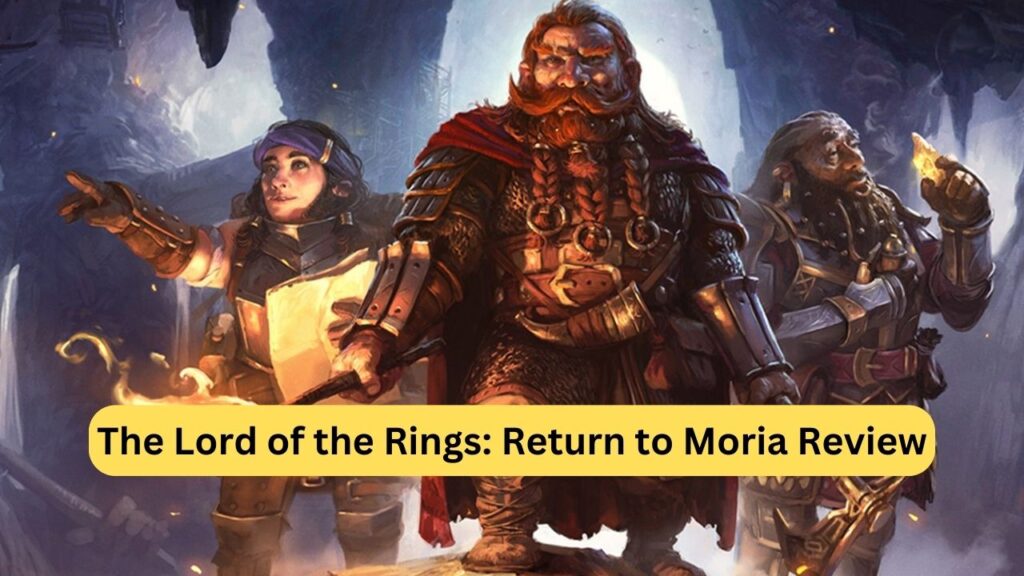The Lord of the Rings: Return to Moria Review

“The Lord of the Rings: Return to Moria” is a survival-crafting video game developed by Free Range Games and published by North Beach Games.
Released on October 24, 2023, for PC, with subsequent releases planned for PlayStation 5 and Xbox Series X/S, the game invites players to explore the iconic Mines of Moria, a location rich in lore from J.R.R. Tolkien’s Middle-earth.
Set in the Fourth Age, after the defeat of Sauron, the game focuses on the dwarves’ efforts to reclaim their ancient kingdom from various threats, including goblins and other dark creatures.
This article delves into the game’s development, gameplay mechanics, narrative elements, and overall reception.

Development and Concept
The concept of “Return to Moria” draws inspiration from Tolkien’s appendices in “The Lord of the Rings,” where the idea of dwarves reclaiming Moria is hinted at.
The game is designed to immerse players in the dwarven experience, allowing them to explore their culture, history, and struggles.
Developed using Unreal Engine, the game emphasizes survival mechanics, requiring players to manage resources, craft items, and navigate the treacherous environment of Moria.
The development team, Free Range Games, aimed to create a unique blend of survival and crafting elements while staying true to the rich lore of Middle-earth.
The game features a character creation system that allows players to customize their dwarven avatars, enhancing the personal connection to the gameplay experience.
Gameplay Mechanics
Survival-Crafting Elements
“Return to Moria” is primarily classified as a survival-crafting game. Players are tasked with gathering resources, crafting tools and managing their character’s needs such as hunger, sleep, and body temperature.
The gameplay emphasizes exploration and resource extraction, with players mining for valuable materials like iron, gold, and mithril across procedurally generated environments.
Key gameplay features include:
- Resource Extraction: Players must mine various ores and materials to craft essential items for survival.
- Building and Customization: The game encourages players to rebuild ancient dwarven structures, creating a sense of ownership and progress within the game world.
- Combat: Players face threats from orcs, cave trolls, and other creatures inhabiting the mines.
- Combat mechanics require players to either engage directly or use stealth to navigate dangerous encounters.
- Multiplayer Mode: The game supports cooperative multiplayer, allowing players to team up with friends to explore Moria together.
- Up to eight players can join a single host’s game, enhancing the experience through collaboration.
Narrative and Setting
Set in the aftermath of the War of the Ring, “Return to Moria” explores the dwarves’ attempts to reclaim their homeland from darkness.
The story begins with a cinematic introduction featuring Gimli, who calls upon dwarves from across Middle-earth to assist in the reclamation of Khazad-dûm.
However, a mysterious explosion separates the player from the rest of the expedition, setting the stage for a journey filled with exploration and discovery.
Throughout the game, players encounter familiar locations and references from Tolkien’s works, such as the room where Pippin dropped the stone and the iconic Doors of Durin.
While the narrative serves as a backdrop for gameplay, it also provides opportunities for players to engage with the lore through songs and interactions with the environment.
Reception and Critique
Upon its release, “Return to Moria” received a mixed reception from critics and players alike. The game has been praised for its atmospheric environments and the nostalgic appeal of exploring the Mines of Moria. However, it has also faced criticism for its gameplay mechanics and technical issues.
Positive Aspects
- Atmospheric Design: Many players and reviewers have noted the game’s ability to create an immersive atmosphere that captures the essence of Moria.
- The environments are described as beautifully crafted, with a sense of foreboding that enhances the gameplay experience.
- Nostalgic References: The game effectively weaves in elements from Tolkien’s lore, providing fans with familiar locations and moments that evoke nostalgia.
- Multiplayer Experience: The cooperative gameplay aspect has been highlighted as a significant strength, allowing players to share the adventure and tackle challenges together.
Criticisms
- Gameplay Mechanics: Critics have pointed out that while the game incorporates survival-crafting elements, it does not innovate upon the established mechanics of the genre.
- Many aspects, such as combat and building systems, have been described as lacking polish and depth compared to other titles.
- Technical Issues: Players have reported various bugs and glitches, including audio dropouts, quest marker issues, and performance problems in multiplayer mode.
- These technical shortcomings have detracted from the overall experience, leading to frustration among players.
- Narrative Depth: While the game includes references to Tolkien’s works, some critics argue that the narrative is thin and often overshadowed by the gameplay, making it easy to forget the story amidst the survival mechanics.
Conclusion
“The Lord of the Rings: Return to Moria” offers a unique take on the survival-crafting genre, set against the backdrop of one of fantasy literature’s most beloved locations.
While it successfully immerses players in the lore of Middle-earth and provides an engaging multiplayer experience, it also faces challenges related to gameplay mechanics and technical issues.
As the game continues to receive updates and patches, there is potential for improvement, allowing it to better fulfil the expectations of both survival game enthusiasts and fans of Tolkien’s work.
In summary, “Return to Moria” stands as an intriguing addition to the Lord of the Rings gaming landscape, inviting players to explore the depths of Moria while balancing the challenges of survival and crafting in a richly detailed world.
With ongoing support and refinement, it may evolve into a more polished experience that resonates with a broader audience.




